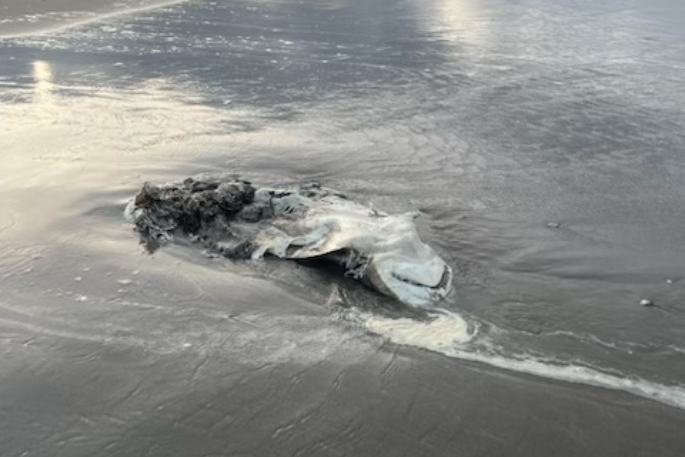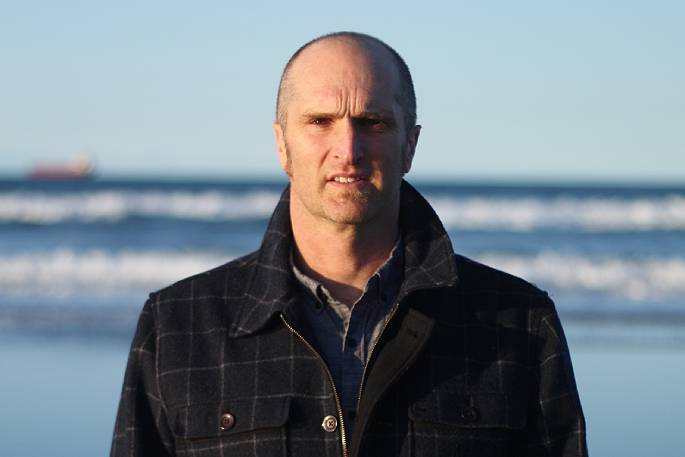A clearer picture has emerged in the case of a shark washing up on the shores of Mount Maunganui.
Last week, multiple passers-by at the scene described the shark as 'badly decomposed” and reported the species of shark as a great white.
Following the event, clearer photos of the shark carcass started to spread, and Waikato University marine biologist Phil Ross was among those to realise the 'great white” was in fact a bronze whaler shark.
'Once I saw clearer photos published later in the day, I realised quite quickly it was a ‘bronzey,'” says Phil.
'When I was told it was a great white, I made the mistake of accepting that as a fact without seeing it myself or getting hold of an up close photo.
'With a decent photo, it is really not difficult to tell the differences between a bronze whaler and a great white. But those clearer photos didn't come in until a bit later.”
 The first photo of the washed up bronze whaler made it difficult to identify the species. Photo: Supplied/SunLive.
The first photo of the washed up bronze whaler made it difficult to identify the species. Photo: Supplied/SunLive.
Phil adds once he found the shark, it looked as though it had 'been dead for a while”.
'I did eventually find it a few days later. It was certainly very decomposed and not fresh.
'Where getting the facts right is important lies in the concerns people have. Everyone knows there is lots of bronze whaler sharks and they have always been up and down our coastlines in large numbers.
'There also isn't a high number of human interactions with them. We are at the point now where there is a lot of reports of an increase in great whites, so if there is any shark species that washes up on the shores it automatically gets labelled as a great white.
'It is important to get the species right so the public is well informed, and people don't have to be concerned about great whites when it wasn't one.
This occasion of wrong information being spread has been a 'good lesson” according to Phil, as he says it is important to not jump to conclusions.
'In this case, I had a screenshot of a photo showing the shark, and I accepted whoever had seen it had got it right.”
 Phil Ross is a researcher at the University of Waikato. Photo: Supplied/SunLive.
Phil Ross is a researcher at the University of Waikato. Photo: Supplied/SunLive.
In regards to Phil's research project, the bronze whaler would have still been good to take a look at, but would not have been utilised in the same way as a great white.
'Last week we had STEMFest, and the University of Waikato did a shark dissection for the public. Some sharks that wash up can be used for educational purposes in that sense.
'If it was a great white, we could have gathered a photo identification as there is so few of them. In Tauranga we don't know how many there are, but they are certainly not common.
'We would have compared the shark to the photo records we have if it was a great white. It being a bronze whaler, we are not even going to attempt to get that sort of information.”
Phil says although the bronze whaler sharks are far more common, they are far less studied.
'Bronze whalers are probably the least studied large shark species on the planet. I guess they don't have a lot of the same charisma as a great white or whale shark, which have been a lot more alluring and mysterious to researchers.
"A bronze whaler washing up is still significant however, you don't hear of sharks in general washing up often."
As for what is happening to the bronze whaler now, Phil says the shark has certainly past the point of being of much use.
'By the time I found it, the shark was pretty much skin and bones. It was past being of any use to us.
'However, if any other sharks wash up on beaches around Tauranga, we are still keen for people to let us know.
'Depending on what research is being done at the time, we could use a washed up shark to contribute, or find another educational use.”
To contact Phil about sharks washing up on beaches in and around Tauranga, email phil.ross@waikato.ac.nz.



1 comment
Expert
Posted on 11-10-2022 07:33 | By Slim Shady
Jumping to conclusions and presenting them as facts. Nothing new there.
Leave a Comment
You must be logged in to make a comment.